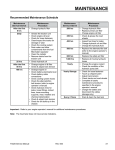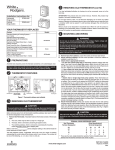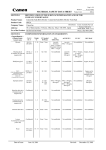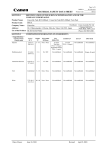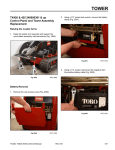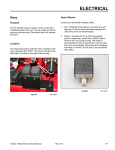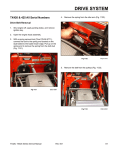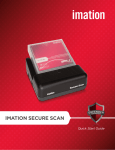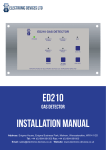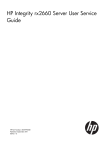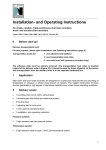Download MAINTENANCE
Transcript
MAINTENANCE Recommended Maintenance Schedule Maintenance Service Interval Maintenance Procedure 8 hrs • • • • • 25 hrs • Check hydraulic oil5 • Inspect hydraulic lines for leaks 50 hrs • Clean the foam pre-filter with liquid soap and warm water • Clean the paper air filter by lightly tapping on flat surface 100 hrs • • • • • Change engine oil1, 2 Replace paper air filter1 Check battery electrolyte level Adjust track tension Check battery cable connections 200 hrs • • • • • Check hydraulic filter1, 3, 4 Check spark plugs Replace drive belt Replace fuel filter Change engine oil filter 400 hrs • Inspect fuel lines for leaks • Change hydraulic oil and filter1 Yearly Storage • • • • • • • Grease the traction unit Check engine oil level Check for loose fasteners Inspect the tracks for damage or wear Change hydraulic filter after the initial 8-10 operating hours Check for loose fasteners Touch up chipped paint Adjust track tension Check tracks and road wheels Complete all yearly maintenance procedures specified in the engine operator’s manual Charge the battery and disconnect the cables (storage only) Drain the gasoline (storage only) More often in dusty, dirty conditions Change oil after the first 50 operating hours 3 Change the hydraulic filter after the first 8 - 10 operating hours 4 For severe duty or rental applications, change every 200 operating hours 5 Check the hydraulic fluid level before using the traction unit for the first time 1 2 Important: Refer to your engine operator’s manual for additional maintenance procedures. Note: After 50 hours and then every 100 hours therafter (that is at 150, 250, 350, etc.) the screen displays CHG OIL to remind you to change the engine oil. After every 100 hours, the screen displays SVC to remind you to perform the other maintenance procedures based on a 100, 200, or 400 hour schedule. These reminders come on starting three hours prior to the service interval time and flash at regular intervals for six hours. Dingo TX420, TX425 Series Service Manual Rev. 000 3-1 MAINTENANCE Greasing the Traction Unit (4) are located on the right side (Fig. 0002). Grease all pivot joints every 8 operating hours and immediately after every washing. Grease Type: Lithium based NLGI2 1. Lower the loader arm and stop the engine. Remove the key from the ignition switch. 2. Clean the grease fittings with a rag. 3. Connect grease gun to each fitting and pump grease into the fittings until grease begins to ooze out of the bearings (approximately 3 pumps). 4. Wipe any excess grease. There are 12 grease fittings on the TX420/425: (4) are located on the left side (Fig. 0001). Fig 0002 IMG-6883a (4) are located in the front on the quick attachment assembly and the front loader arm assembly (Fig. 0003). Fig 0001 IMG-6881a 3-2 Rev. 000 Fig 0003 IMG-6882a Dingo TX420, TX425 Series Service Manual MAINTENANCE Maintaining the Road Wheels 4. Ensure that the road wheel turns smoothly on the bearing. If it does not turn smoothly or spin freely, replace the bearing; refer to Road Wheel Bearing Replacement, page 8-108. 1. If the inner wheels or the complete tray of wheels needs maintenance, remove the tracks. Refer to “Track Removal” as follows: • TX420 page 8-4 • TX425 (with a cast drive wheel) page 8-13 • TX425 (with drive sprocket wheel) page 8-29 5. Check the grease under the cap and around the gasket. If it is dirty, gritty, or depleted, clean out all of the grease, replace the gasket, and fill the head of the cap with new grease (Fig. 0006). 2. Remove the snap ring from a road wheel (Fig. 0004). Fig 0004 Note: It is not always necessary to remove the track guide when replacing any of the road wheel bearings. They can also be removed by raising the unit off the ground. For safety reasons, make sure the frame of the unit is supported. DSC-0821a 3. Remove the wheel bearing cap with seal (Fig. 0005). Fig 0005 Dingo TX420, TX425 Series Service Manual Fig 0006 DSC-0835a DSC-0822 Rev. 000 3-3 MAINTENANCE Hydraulic Reservoir Tank 5. Remove the cap from the filler neck and check the fluid level on the dipstick (Fig. 0008). Location The hydraulic reservoir tank is located in the front of the TX420/TX425 unit. Hydraulic Tank Capacity: 10 gallons (37.85 liters) Type of Oil to Use: 10W-30 detergent, diesel engine oil (API service CH-4 or higher) Checking the Hydraulic Fluid Check the hydraulic fluid level before the engine is first started and after every 25 operating hours. 1. Remove the attachment, if one is installed. 2. Park the traction unit on a level surface, lower the loader arm, and fully retract the tilt cylinder. 3. Stop the engine, remove the key, and and allow the engine to cool. 4. Clean the area around the filler neck of the hydraulic tank (Fig. 0007). 3-4 Fig 0007 Fig 0008 PICT-5528 6. The fluid level should be between the marks on the dipstick. If the level is low, add enough fluid to raise it to the proper level. 7. Install the cap on the filler neck. IMG-6890 Rev. 000 Dingo TX420, TX425 Series Service Manual MAINTENANCE Replacing the Hydraulic Filter (TX420/425 250000401 & up Fig. 0010) Change the hydraulic filter: • After the first 8 operating hours. • After every 200 operating hours. 1. Position the traction unit on a level surface. 2. Lower the loader arm, stop the engine, and remove the key. 3. Open the hood. IMPORTANT: Do not substitute an automotive oil filter or severe hydraulic system damage may result. 4. Remove the old filter (TX420/425 250000399 & lower Fig. 0009). Fig 0010 IMG-6886a 5. Wipe the surface of the filter adapter gasket area clean. 6. Pre-fill the hydraulic oil filter with oil and apply a thin coat of oil to the rubber gasket on the replacement filter. 7. Install the replacement hydraulic filter onto the filter adapter. Hand tighten it clockwise until the rubber gasket contacts the filter adapter, then tighten the filter an additional 3/4 turn. 8. Wipe up any spilled fluid. Fig 0009 IMG-6900a 9. Start the engine, raise and lower the loader arm, then drive the unit forward and backward to purge air from the system and check for leaks. 10. Stop the engine, check the fluid level in the hydraulic tank (refer to “Checking the Hydraulic Fluid”, page 3-4) and add fluid to raise the level to the mark on the dipstick. Do not over fill the tank. 11. Close the hood. Note: Dispose of used oil and filters at a certified recycling center. Dingo TX420, TX425 Series Service Manual Rev. 000 3-5 MAINTENANCE Changing the Hydraulic Fluid 6. Remove the hydraulic tank cap and dipstick (Fig. 0012 and Fig. 0013). Change the hydraulic fluid every 400 operating hours or yearly. Note: The hydraulic filter should be replaced whenever the hydraulic oil is changed. 1. Position the traction unit on a level surface. 2. Raise the loader arm, install the cylinder lock, stop the engine, and remove the key. 3. Open the hood. 4. Allow the traction unit to cool completely. 5. Place a large drain pan (capable of holding a minimum of 11 gallons) under the drain plug on the front of the traction unit, behind the front counterweight (Fig. 0011). Fig 0012 IMG-6890 Fig 0013 PICT-5528 3-6 Fig 0011 IMG-7023 Rev. 000 Dingo TX420, TX425 Series Service Manual MAINTENANCE 7. Remove the drain plug and allow the oil to drain into the pan. 8. When oil is finished draining, install and tighten the drain plug. Note: Dispose of the used oil at a certified recycling center. 9. Fill the hydraulic tank with approximately 10 gallons (37.8 liters) of 10w-30 or 15W-40 detergent, diesel engine oil (API service CH-4 or higher). 10. Replace the hydraulic filter. Refer to “Replacing the Hydraulic Filter” on page 3-5. Checking the Hydraulic Lines After every 100 operating hours, check the hydraulic lines and hoses for leaks, loose fittings, kinked lines, loose mounting supports, wear, and weather or chemical deterioration. Replace all moving hydraulic hoses every 1500 hours or 2 years, whichever comes first. Make necessary repairs before operating. Vents - Hydraulic Tank The vent location depends on the serial number of the TX. 11. Start the engine, remove the cylinder lock, raise and lower the loader arm, then drive the unit forward and backward to purge air from the system and check for leaks. Note: The only maintenance to perform on these is to make sure they are clean and free of any debris. 12. Stop the engine. 240000299 & lower, the vent is in front of the hydrostat pumps attached to the engine baffle (Fig. 0015). 13. Check the hydraulic fluid level and top it off if necessary. 14. Replace the hydraulic tank cap and dipstick (Fig. 0014). Fig 0014 Dingo TX420, TX425 Series Service Manual Fig 0015 IMG-7048 IMG-6890 Rev. 000 3-7 MAINTENANCE 240000301 & up, the vent is located in front of the engine secured to the oil cooler frame (Fig. 0016). Oil Drain (behind the left track) (Fig. 0018) Fig 0016 Fig 0018 A Engine Servicing Oil Dipstick - check oil level daily (Fig. 0017). B D C Fig 0019 A. Oil fill B. Spark plug 3-8 Fig 0017 IMG-6899 IMG-7056 IMG-6895 C. Oil filter D. Fuel filter IMG-6901 Rev. 000 Dingo TX420, TX425 Series Service Manual MAINTENANCE • Change oil after the first 50 hrs then every 100 hrs1, 2 Fuse Block • Oil Filter 200 hrs1, 3 Fuses are located under the hood, mounted to the tower assembly (Fig. 0021). • Fuel Filter 200 hrs1 • Inspect Spark Plug 200 hrs (Gap 0.030” (0.76mm)) More often in dusty, dirty conditions. Change oil after the first 50 operating hours. 3 For severe duty or rental applications, change every 3 100 operating hours. 1 2 Refer the Kohler or Toro Operator manuals for additional information. ABCD Air Filter Every 25 hrs check and clean pre-filter and check the paper element for damage (Fig. 0020).* A. B. C. D. Fig 0021 IMG-6972 15 amp = Fan motor 10 amp = Neutral switch and gauges 25 amp = Charge and fuel solenoid 30 amp = Start circuit Fuses can be removed to check continuity. The test meter should read less than 1 ohm. Fig 0020 IMG-6897 • Replace Paper Element 100 hrs* * More often in dusty, dirty conditions Dingo TX420, TX425 Series Service Manual Rev. 000 3-9 MAINTENANCE Belt, Hydrostatic Pumps Track Inspection Every 25 hours inspect the drive belt for wear or damage. Clean the track and drive assembly daily. Check the track surface daily for cracks and tears. Every 200 hours replace the drive belt. Replace the belt if you find any signs of wear, cracks, or damage or after 200 operating hours, whichever comes first (Fig. 0022). Replace the track if it is torn or cut and/or the tread is worn (Fig. 000). Check the center lugs daily for gouging and excessive wear (Fig. 000). Track Adjustment 2 3/4” (7cm) (Fig. 0023). 1. = 2-3/4 inches (7cm) Fig 0022 A IMG-6889 B Fig 0023 A. Tension nut track install #3 B. Tensioner arm Use an alignment tool (Toro p/n: 110-0069) to align the track guide to drive wheel prior to track installation or if the track lugs show wear. Refer to “Track Guide Alignment” as follows: • TX420 page 8-112 • TX425 page 8-114 Replace the track if most of the center lugs are gouged or worn 1/2” (1.27cm) on either side or a combination of both sides. Nominal lug width is 2 1/2” (6.35cm) at the base of the lug. Refer to “Track Installation” as follows: • TX420 page 8-12 • TX425 (cast drive wheel) page 8-19 • TX425 (drive sprocket wheel) page 8-49 3-10 Rev. 000 Dingo TX420, TX425 Series Service Manual MAINTENANCE Battery Maintenance Track Tread (Fig. 0024) Batteries are available in two basic versions; maintenance free and maintenance type. With either type of battery it is important to have clean terminals and tight cable connections to the battery posts. Escaping gases from the battery causes corrosion at the terminals and other metal parts. The battery should be cleaned periodically using a baking soda and water mix; a couple of tablespoons baking soda to a pint of water. Fig 0024 PICT-3377 A maintenance type battery needs fluid level checks on a routine basis. Use distilled water to bring the battery cells to the correct level. Check and clean electrical connections and the changing system if the battery requires water frequently and corrosion becomes excessive; both are signs of over-charging. A maintenance free battery is sealed and fluid can not be added. Center Lug (Fig. 0025) Cold cranking amps (CCA) is a measurement of the number of amps a battery can deliver at 0° F (-17° C) for 30 seconds and not drop below 7.2 volts. So a high CCA battery rating is good, especially in cold weather. Sulfation of batteries starts when specific gravity falls below 1.225 or voltage measures less than 12.4 (12v Battery). Sulfation hardens the battery plates reducing and eventually destroying the ability of the battery to store a charge. Fig 0025 Dingo TX420, TX425 Series Service Manual PICT-3378 Rev. 000 3-11 MAINTENANCE Sulfation is a normal process that slowly occurs over time and is the reason a battery eventually needs replacement. However, a battery that is allowed to become discharged and is left in this state will suffer permanent sulfation damage and require premature replacement. Occasional charging of the battery during storage is recommended to the keep the specific gravity to recommended levels. This will minimize the sulfation of the battery plates. State of Charge Specific Gravity Voltage 12V 100% 1.265 12.7 75% 1.225 12.4 50% 1.190 12.2 25% 1.155 12.0 Discharged 1.120 11.9 Special Tools Listed below are the special tools used in some of the procedures in this manual. To order these tools, contact the Toro Company. Track Alignment Tool (Fig. 0026) - Toro P/N: 110-0069 For tool use example see page 8-113. Testing You must first have the battery fully charged prior to any test. The surface charge must be removed before testing. To remove surface charge the battery must experience a load of 20 amps for 3 plus minutes. Battery specific gravity can be measured by using a hydrometer or a refractometer. Fig 0026 PICT-4139a Wheel Puller Kit (Fig. 0027) - Toro P/N: 112-2557 For tool use example see page 8-68. Load test removes amps from a battery much like starting an engine would. The battery may have a label with the amp load for testing and/or a CCA Cold Cranking Amp rating. The load test number is 1/2 of the CCA rating. For example, a 500 CCA battery would load test at 250 amps for 15 seconds. A load test can only be performed if the battery is near or at full charge. If you have a maintenance free battery, the only ways to test are with a voltmeter and/or a load test. The reading on the digital voltmeter should be the voltage shown in the previous table. If you have voltage readings in the 10.5 volts range on a charged battery, that indicates a shorted cell. Batteries that are used in equipment that are stored for some portion of the year can discharge and sulfation between the battery plates can occur and shorten the life of the battery. 3-12 Rev. 000 Fig 0027 PICT-4143a Dingo TX420, TX425 Series Service Manual MAINTENANCE Spring Removal Tool (Fig. 0028) - Toro P/N: 92-5771 For tool use example see page 8-1. Fig 0028 Dingo TX420, TX425 Series Service Manual PICT-4131a Rev. 000 3-13 MAINTENANCE THIS PAGE INTENTIONALLY LEFT BLANK. 3-14 Rev. 000 Dingo TX420, TX425 Series Service Manual














